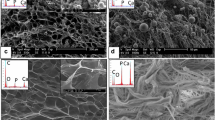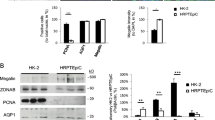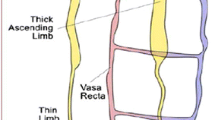Abstract
Cell culture models of calcium phosphate renal stone formation were established using the MDCK cell line. Renal microliths were detected within pseudocysts in three-dimensional soft agar cultures, and were also observed in the basal region of cells lining the cell sheet, and immediately beneath domes or blisters in monolayers and collagen gel cultures. Light and scanning electron microscopy indicated that these microliths had a similar lamellated and spherical appearance to those in humans. These microliths were first detected microscopically after 21 days of culture, and were found to be composed of calcium phosphate by X-ray and microinfrared spectroscopic analyses. These culture models may provide a powerful new tool to study the pathogenesis of renal stone diseases and/or calcium phosphate stone formation in humans and animals.
Similar content being viewed by others
References
Anderson CK (1979) The anatomical aetiology of renal lithiasis. In:Wickham J EA (ed) Urinary calculus disease. Churchill Livingstone, London, 40
Aso Y, Ohtawara Y, Fukuta K, Sudoko H, Nakano M, Ushiyama T, Ohta N, Suzuki K, Tajima A (1987) Operative fiberoptic nephroureteroscopy: Removal of upper ureteral and renal calculi. J Urol 137:629
Atmani F, Opalko FJ, Khan SR (1996) Association of urinary macromolecules with calcium oxalate crystals induced in vitro in normal human and rat urine. Urol Res 24:45
Barckhaus RH, Hohling HJ, Fromm I, Hirsch P, Reimer L (1991) Electron spectroscopic diffraction and imaging of the early and mature stages of calcium phosphate formation in the epiphyseal growth plate. J Microsc 162:155
Breuer WV, Mack E Rothstein A (1988) Activation of K+ and Cl−1 channels by Ca2+ and cyclic AMP in dissociated kidney epithelial (MDCK) cells. Pflügers Arch 411:450
Coe FL, Parks JH (1988) Nephrolithiasis: Pathogenesis and treatment (2nd edn). Year Book Medical Publishers, Chicago, pl
Coe FL, Nakagawa Y, Asplin J, Parks JH (1994) Role of nephrocalcin in inhibition of calcium oxalate crystallization and nephrolithiasis. Miner Electrolyte Metab 20:378
Curhan GC, Curhan SG (1994) Dietary factors and kidney stone formation. Compr Ther 20:485
De Bruijn WC, Boeve ER, van Run PR, van Miert PP, de Water R, Romiji JC, Verkoelen CF, Cao LC, Schroder FH (1995) Etiology of calcium oxalate nephrolithiasis in rat. I. Can this be a model for human stone formation? Scanning Microsc 9:103
De Bruijn WC, Boeve ER, van Run PR. van Miert PP, de Water R, Romijn JC, Verkoelen CF, Cao LC, van 't Noordende JM, and Schrder FH (1995) Etiology of calcium oxalate nephrolithiasis in rats. II. The role of the papilla in stone formation. Scanning Microsc 9:115
De Vita MV, Zabetakis PM (1993) Laboratory investigation of renal stone disease. Clin Lab Med 13:225
Gaush CR, Hard WL, Smith TF (1966) Characterization of an established line of canine kidney cells (MDCK). Proc Soc Exp Biol Med 122:931
Goldfarb S (1994) Diet and nephrolithiasis. Annu Rev Med 45:235
Grases F, Sohnel O (1993) Mechanism of oxalocalcic renal calculi generation. Int Urol Nephrol 25:209
Grover PK, Ryall RL, Marshall VR (1992) Calcium oxalate crystallization in urine: role of mate and glycosaminoglycans. Kidney Int 41:149
Herzlinger DA, Eeston TG, Ojakian GK (1982) The MDCK epithelial cell line expresses a cell surface antigen of the kidney distal tubule. J Cell Biol 93:269
Hess B (1994) Tamm-Horsfall glycoprotein and calcium nephrolithiasis. Miner Electrolyte Metab 20:393
Hill GS (1992) Calcium and the kidney, nephrolithiasis, and hydronephrosis. In: Heptinstall RH (ed) Pathology of the kidney (4th edn). Little Brown, Boston, p 1563
Joos RW, Carr CW (1967) The binding of calcium in mixtures of phospholipids. Proc Soc Exp Biol Med 124:1268
Kennedy SM, Flanagan JL, Mills JW, Friedman PA (1989) Stimulation by parathyroid hormone of calcium absorption in confluent Marin-Darby canine kidney cells. J Cell Physiol 139:83
Khan SR (1995) Calcium oxalate crystal interaction with renal tubular epithelium, mechanism of crystal adhesion and its impact on stone development. Urol Res 23:71
Khan SR (1995) Experimental calcium oxalate nephrolithiasis and the formation of human urinary stones. Scanning Microsc 9:89
Lieske JC, Swift H, Martin T, Patterson B, Toback FG (1994) Renal epithelial cells rapidly bind and internalize calcium oxalate monohydrate crystals. Proc Natl Acad Sci USA 91:6987
Mandel N (1994) Crystal-membrane interaction in kidney stone disease. J Am Soc Nephrol 5 (Suppl 1):S37
Mandel N, Riese R (1991) Crystal-cell interactions: crystal binding to rat renal papillary tip collecting duct cells in culture. Am J Kidney Dis 17:402
Menon M (1993) A prospective study of dietary calcium and other nutrients and the risk of symptomatic kidney stones. J Urol 150:563
Pak CY (1994) Citrate and renal calculi: an update. Miner Electrolyte Metab 20:371
Peacock M, Robertson WG (1979) The biochemical aetiology of renal lithiasis. In:Wickham JEA (ed) Urinary calculus disease. Churchill Livingstone, London, p 69
Prien EL (1975) The riddle of Randall's plaques. J Urol 114:500
Randall A (1936) A hypothesis for the origin of renal calculus. N Engl J Med 214:234
Randall A (1937) The origin and growth of renal calculi. Ann Surg 105:1009
Randall A (1940) Papillary pathology as a precursor of primary renal calculus. J Urol 44:580
Riese RJ, Riese JW, Klineman JG, Wiessner JH, Mandel GS, Mandel NS (1988) Specificity in calcium oxalate adherence to papillary epithelial cells in culture. Am J Physiol 255:F1025
Robertson WG, Peacock M (1972) Calcium oxalate crystalluria and inhibitors of crystallization in recurrent renal stone-formers. Clin Sci 43:499
Robertson WG, Peacock M, Nordin BEC (1971) Calcium oxalate crystalluria and urine saturation in recurrent renal stoneformers. Clin Sci 40:365
Rosen S, Greenfeld Z, Bernheim J, Rathaus M, Podjarny E, Brezis M (1990) Hypercalcemic nephropathy: Chronic disease with predominant medullary inner stripe injury. Kidney Int 37:1067
Ryall RL (1993) The scientific basis of calcium oxalate urolithiasis. Predilection and precipitation, promotion and prescription. World J Urol 11:59
Scheinman SJ, Pook MA. Wooding C, Pang JT, Frymoyer PA, Thakker RV (1993) Mapping the gene causing X-linked recessive nephrolithiasis to Xp 11.22 by linkage studies. J Clin Invest 91:2351
Suzuki H, Naito Y (1991) An in vitro study on the characteristics of osteoblastic cells derived from human mandibular periosteum (in Japanese). J Jpn Stomatol Soc 40:89
Termine JD, Klineman HK, Whitson SW, Conn KM, McGarvey ML, Martin GR (1981) Osteonectin, a bone specific protein linking mineral to collagen. Cell 26:99
Torres VE, Wilson DM, Hattery RR, Segura JW (1993) Renal stone disease in autosomal dominant polycystic kidney disease. Am J Kidney Dis 22:513
Van Aswegen CH, Dirksen van Sckalckwyk JC, du Toit PJ (1992) The effect of calcium and magnesium ions on urinary urokinase and silicase activity. Urol Res 20:41
Verdier JM, Dussol B, Casanova P, Daudon M, Dupuy P, Berthezene P, Boistelle R, Berland Y, Dagorn JC (1993) Renal lithostathine: a new protein inhibitor of lithogenesis. Nephrologie 14:261
Wandzilak TR, Calo L, D'Amdre S, Borsatti A, Williams HE (1992) Oxalate transport in cultured porcine renal epithelial cells. Urol Res 20:341
Wang YH, Grenabo L, Hedelin H, McLean RJ, Nickel JC, Pettersson S (1993) Citrate and urease-induced crystallization in synthetic and human urine. Urol Res 21:109
Author information
Authors and Affiliations
Rights and permissions
About this article
Cite this article
Naito, Y., Ohtawara, Y., Kageyama, S. et al. Morphological analysis of renal cell culture models of calcium phosphate stone formation. Urol. Res. 25, 59–65 (1997). https://doi.org/10.1007/BF00941907
Received:
Accepted:
Issue Date:
DOI: https://doi.org/10.1007/BF00941907




